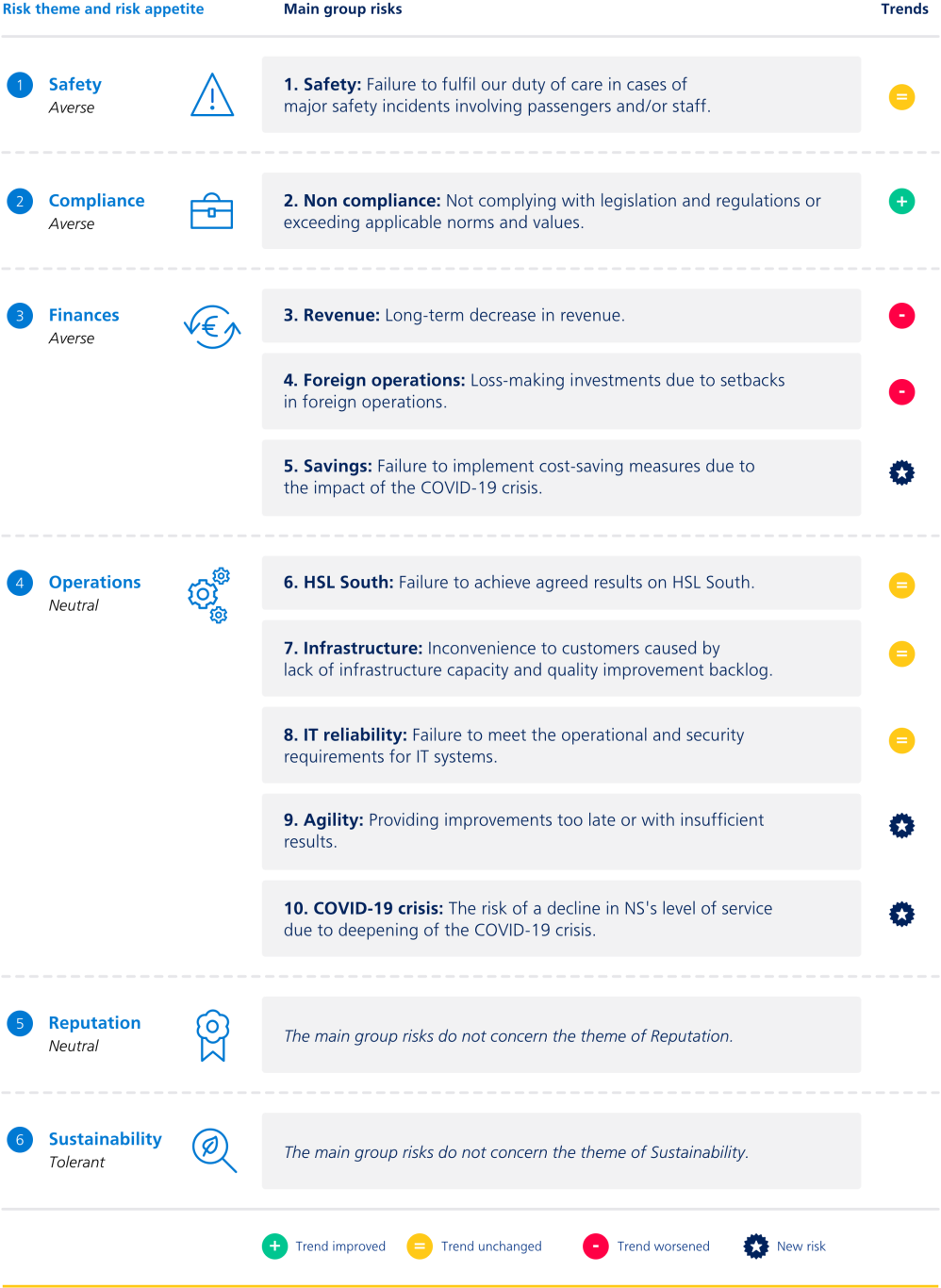Risk management is all about targeting uncertainties that could impede the achievement of the strategic objectives. To provide a picture of our risk management approach, this chapter looks at risk appetite, the organisation of risk management and the key risks.
NS operates a risk management framework that comprises eight components. These serve as the basis for risk management processes within NS:

Organisation of risk management
To ensure permanent integral management of risks, risk management must move along with internal and external developments. In 2020, NS took steps to adjust its risk appetite by enhancing risk awareness and using quantitative analyses. We use probabilistic planning schedules and analyses to present a realistic picture of the future impact of uncertainties and risks, so as to gain better insight into the reliability of project-related plans, policy choices and risk budgets. This supports the decision-making process. In 2020, we adopted this approach once again in various business units, also devoting attention to securing business continuity management within the organisation, and to climate-related risks that could potentially impact NS operations.
Recording and reporting
Identified risks, including the risk owners, have been recorded in risk registers and are assigned quantitative scores using a single, uniform risk matrix. We implemented a new NS-wide risk matrix in line with the adjusted risk appetite profile. Every three months, NS reports the main risks for each business unit; those reports are discussed in the Executive Board as part of the planning and control cycle. Any risks that fall outside our risk appetite are reported immediately and escalated where necessary. The Executive Board reports on and renders account for the risk management and internal control system to the Supervisory Board after discussing it in the Risk and Audit Committee.
Risk appetite and risk tolerance
The risk appetite and risk management we are aiming for in six risk themes at NS can be found in our ‘risk appetite statements’. Each risk theme is linked to specific performance indicators with a quantitative bandwidth. Every year, the Executive Board evaluates and, if necessary, adjusts the risk appetite for each theme. The table below presents the current risk appetite for each risk theme plus the most important group risks. We apply a uniform method for determining the risk appetite for all of these themes, which also covers the subsidiaries Abellio UK and Abellio Germany.
We have plotted individual risks in the NS Risk Matrix and provide explanatory notes in the last table of this chapter. NS's risk appetite changed in 2020, as a result of the impact of the COVID-19 crisis and the associated government measures on our financial situation. As a consequence, we have become more risk averse when it comes to the category ‘finance’. Specifically, this means that financial risks are now more likely to qualify as unacceptable in the risk matrix.

Key changes in the risk profile compared with 2019
The table on the next page shows how the profile for NS's most significant risks changed in 2020 and what measures have been taken to mitigate those risks. The most significant changes are explained below.

Decrease of top risks
Two risks identified in the 2019 Annual Report decreased sharply in 2020 and no longer qualify as top risks for NS. These are ‘Staff shortages: discontinuity in crucial processes due to lack of staff’ and 'Market regulation: losing parts of the business activities and the contributions they make to the result'. The potential staff shortage has decreased across the board, but could easily flare up again due to the effects of the COVID-19 crisis (see last risk). In 2020, the Dutch government pledged to grant NS the main rail network franchise, and while the details are yet to be decided, this has strongly reduced the risk of changes in market regulation harming NS's result.
Financial risks
The most significant change in terms of risk profile is seen in the area of finance. NS's revenue fell sharply in 2020. Even though the company introduced drastic measures to cut costs, it will remain uncertain for a relatively long time how our revenue will develop as a result of changes in travel behaviours and our ability to respond to them. Since the agility of our response is crucial, we are taking a whole range of measures to keep our organisation flexible in the longer term. A great many initiatives are being developed to that end, and we are conducting extensive research to predict and quantify passenger behaviour. At the same time, we are facing the considerable challenge of realising the long-term savings programme, as part of a transformation that calls for a significant commitment from all our staff.
Foreign operations
Abellio incurs revenue risks in the United Kingdom. In Germany, foreign investments may not be profitable due to the stiff penalties related to infrastructural problems and to the lack of compensation from clients for increased staff and training costs. Discussions are under way however to prevent Abellio from being held accountable for these issues beyond its control.
Safety
In 2020, NS remained highly risk averse as regards safety, and the company will continue its efforts to further and permanently control this risk. NS has demonstrably learned lessons from railway incidents that occurred in 2020 by implementing technical and organisational improvements.
The COVID-19 crisis
One new risk that emerged in 2020 is NS's inability to deliver the required level of services due to exacerbation of the COVID-19 pandemic. The risk particularly concerns the availability of operational staff. This is why NS is closely monitoring staff levels using the channels designed for that purpose. In 2020, by quickly adapting to changing circumstances NS proved to be sufficiently agile and flexible to keep the Netherlands accessible even during this major crisis.